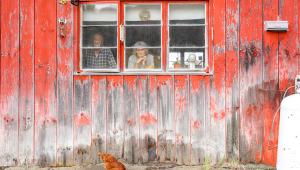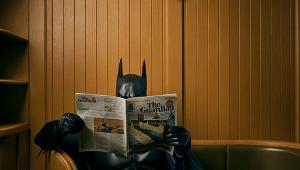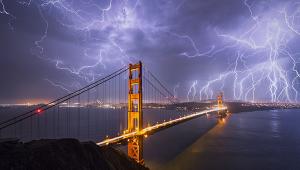Simply Beautiful, Simply Black and White: Cole Thompson’s Artful Images Touch The Soul
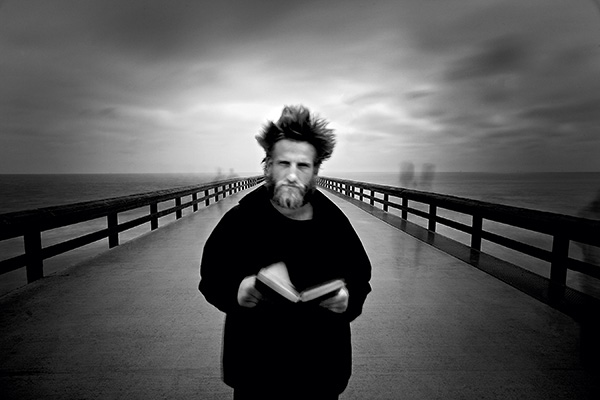
This shot originated as a chance meeting at Newport Beach Pier between the photographer and a homeless person, whom Cole Thompson asked to model for him for what was planned as a long exposure (15 seconds). When the man opened his bible, that’s when Thompson knew he had his shot, letting people in the background appear ghosted.
All Photos © Cole Thompson
Cole Thompson is a refreshing voice in photography, speaking through the medium of black and white as he sees it. Self-taught, he seeks out the simple and intrinsic beauty in life and the world around him. For Thompson, shades of black, white, and gray are enough to define the most complex elements that surround us, even the nature of the universe.
Inspired By Eastman
Thompson’s motivation to get into photography arrived from a classic source. “I was 14, living in Rochester, New York, when a friend and I stumbled upon an old ruin while hiking,” Thompson recalled. “My friend said the house was once owned by George Eastman. That piqued my interest, so I went to the library, read Eastman’s biography—and I was hooked. I was going to be a photographer.” Soon afterward, Thompson had his hands on a Kodak camera and was shooting Kodak Panatomic-X and Tri-X, often pushing Tri-X.
“I always had a darkroom,” he noted. “Initially, I started in black and white because there were no color processes for the home. I cut my teeth on all the great masters.
“My biggest influence back then was Ansel Adams. I spent most of my photographic career trying to be the next Ansel Adams. I even went to Yosemite to try to find where he shot his great images so I could recreate them.”
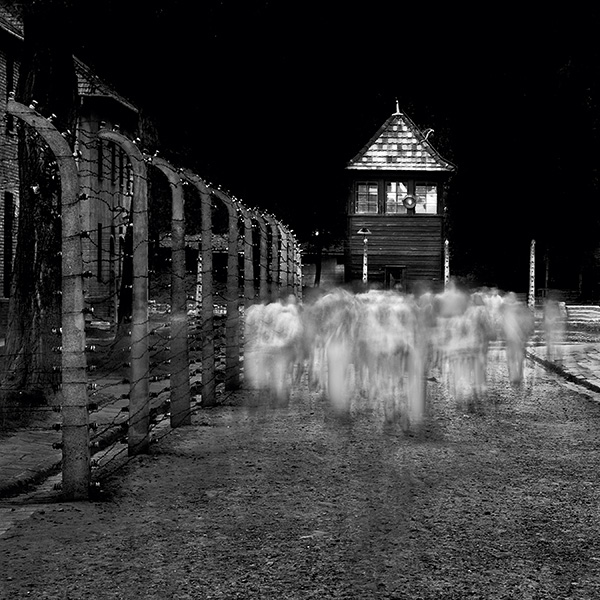
“Europeans are very polite, and when they see someone taking a photograph, they’ll move out of the way. I wanted them in the picture, to appear ghostly, representing prisoners of the concentration camp. So what I did was, I turned my back and pretended to talk on my cell phone so they’d re-enter the shot, at which point I triggered the 10-second exposure with the cable release in my hand.” Thompson used a variable ND, which was “indispensable,” since he needed to recompose the shot quickly.
A Rude Awakening
But that picture would soon change. “I was attending Review Santa Fe in 2004. It was a long day of showing reviewer after reviewer my work, when I came to the last reviewer of the day. I’m tired, and I’m sure he was, too. He looks at my work, pushes it back to me, and brusquely states, ‘It looks like you’re trying to copy Ansel Adams.’ To which I enthusiastically replied, yes. He said something that would change my life. ‘Ansel has already done Ansel; you’re not going to do him better. What can you do that shows me your unique vision?’ The way he delivered it really stung, but it set me about on a two-year journey to find my own vision.”
That eventually led to a new philosophy on photography and on life. “In my later years, I became a fan of Edward Weston. Not his photography as much as his writings and his attitude. I periodically read his daybooks just to try to get my head straight. I see Weston as very similar to Howard Roark in The Fountainhead. You create for yourself and you don’t care what others think. Once you’ve created the image, your duty is done.”

Thompson was shooting these mud hills in eastern Utah, around noon, with temperatures hovering over 100 degrees. Problem was, the scene didn’t have the impact he was hoping for. So he packed up and headed back to his truck—when he noticed a cloud moving toward “his” scene. He ran back and set up the tripod and camera, just in time to make this one exposure. “I had my Moonrise Hernandez moment,” referring to an image by Ansel Adams. “There was a polarizer on the lens to darken the sky, but in post I also darkened the sky considerably.”
Changing With The Times
When he was shooting film, Thompson printed on Kodabromide. With the switch to digital, in 2004, his printing paper obviously had to change. He now prints on Hahnemühle Photo Rag 308, and if he requires glossy, he’ll turn to Epson Exhibition Fiber. He outputs to an Epson Stylus Pro 7900 24-inch printer from a Windows PC.
His cameras of choice today are the Canon EOS 5D Mark II and III. And he just ordered the 5DS R, not because he’s enamored of the technology but for practical reasons. First, the new camera with its 50MP of resolution would allow him to print larger. And second, the camera offers a countdown timer that would make it simpler for him to shoot the long exposures, from seconds to minutes, that are a trademark of his work, thereby allowing him to dispense with his other timers.
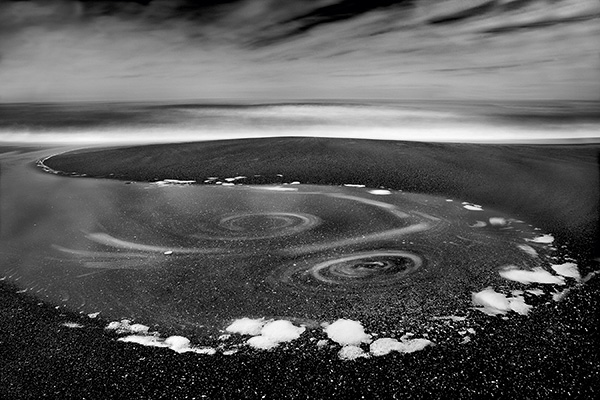
“It was the middle of the day and I was standing on the beach at Bullards Beach State Park, Oregon, looking to be inspired—but nothing came to me. That is, until I walked a little further and came upon this small pool formed by the waves.” The story ends with a 30-second exposure to capture the swirling movement, which formed naturally.
Working In Photoshop
Thompson doesn’t use plug-ins or layers; he doesn’t calibrate his monitors (although he does adjust them for brightness and contrast “so that I know how it’s going to print”); and he doesn’t employ special ink sets. “I use a simple process that revolves around dodging and burning.” Specifically, “I’ll typically underexpose my shot by about one stop from that recommended by the camera meter. Then I dodge the highlights that I feel are important to the shot. I don’t have a lot of shadow detail in most of my work. It’s very blocked up, very dark.” He’ll often burn in the shadows to a deep black, which lends added depth to the image. He added: “When dodging and burning, I do so at 1, 2, and 3 percent, very gradually in layers, so as not to overdo the effect.”
His entire digital workflow is centered in Photoshop CS6. Thompson uses a Wacom Intuos4 tablet, explaining “it’s the only way you can effectively dodge and burn.” That workflow begins with converting the Raw files to 16-bit TIFFs. Toward that end, he takes full advantage of Adobe Camera Raw to bring out as much of the raw essence as possible at this point. The next step involves converting to black and white using the Black & White tool under Adjustments. He tweaks each of the color channels while being careful not to overdo it with the blue channel (for skies, mostly), which he notes will introduce unwanted noise. He then nourishes the image with tonal adjustments in Levels to set a true black-and-white point, followed by the midtone slider. Dodging and burning comes next. That’s followed by increasing contrast to give his creation the same vitality it had on screen. And he ensures that it springs to life fully presentable with the cloning and healing tools.
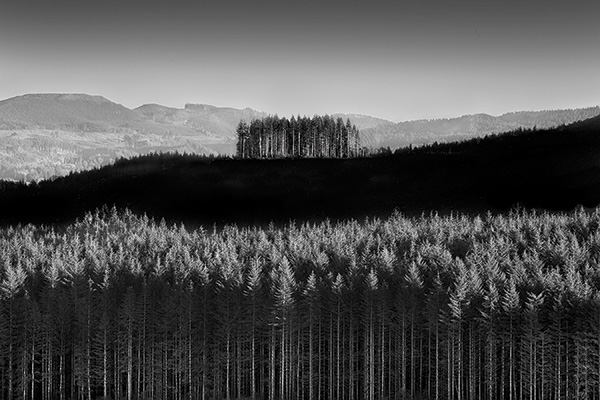
“Logging had destroyed most of the trees, leaving one isolated stand that caught my eye as I was heading to Portland from the Oregon coast. I thought this scene would fit naturally with a project I was working on, which I titled ‘Isolated.’” In post, Thompson accentuated the layers, notably toning down the sky, darkening the middle layer so it formed a contrasting black void, and lightening the foreground tree trunks.
Keeping It Simple
“I’m a minimalist, really. I go on a shoot with the simplest setup I can work with.” Thompson only carries three lenses, all Canon: 16-35mm f/2.8L, 100-400mm IS, and his workhorse 24-105mm f/4L IS. Thompson carries a full-size carbon-fiber tripod with him always, even on vacation. For that matter, he practically goes nowhere without his camera gear. Plus he uses a basic Canon locking cable release for those long exposures.
He doesn’t use lens shades, or work with lenses that come with a permanent lens hood, because that would interfere with his use of filters. Those filters—all 82mm (with step-up rings where needed)—consist of a variety of ND, variable ND, and polarizers, the primary purpose of the ND being to permit him to shoot very long exposures, sometimes lasting minutes. If needed, he shields the lens with his hand to prevent flare.
Thompson noted: “I use variable NDs when things are moving fast and I need to shoot quickly. Fixed neutral density filters are thinner and vignette less, so I use them whenever I have the time to attach and remove filters while composing the image.” He further pointed out that “you cannot combine a variable ND with a polarizer (you get interference patterns), but you can combine a fixed ND filter with a polarizer.”
Thompson prints most of his images in two sizes: 8x12 inches, which he’ll then matte to 16x20 inches, and 10x15 inches, which he mattes to 20x24 inches. “I sell most of my prints, but I also donate some to local charitable causes and to individuals who I learn are having a hard time in life.”
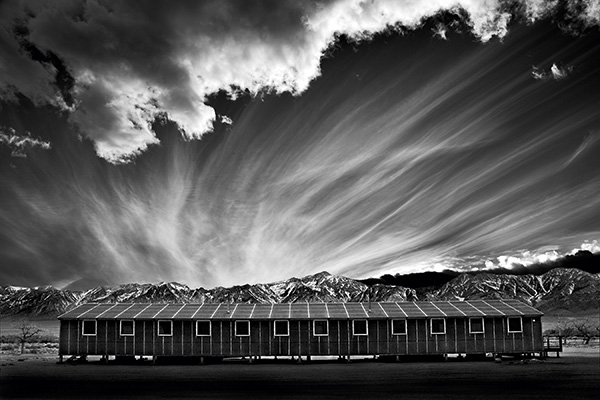
According to the National Park Service, what is now called the “Manzanar War Relocation Center was one of 10 camps where Japanese American citizens and resident Japanese aliens were interned during World War II.” This camp was also the subject of a book by Ansel Adams. Thompson took a completely different tack from Adams, shooting the foreground and sky separately and then compositing them into the final shot. “I’ll often do that where I have a distinct line separating foreground from background, so that I can expose for each individually.” The clouds were actually streaking this way without a time exposure.
What’s In Thompson’s Gear Bag
› Canon EOS 5D Mark III
› Canon EF 16-35mm f/2.8L II USM
› Canon EF 24-105mm f/4L IS USM
› Canon EF 100-400mm f/4.5-5.6L IS II USM
› Hoodman HoodLoupe
› Hoodman HoodEYE eyecup (“to seal out light while metering and setting my exposure”)
› Singh-Ray Vari-ND Variable NeutralDensity Filter
› Singh-Ray Mor-Slo 5, 10, 15, and 20-Stop Solid Neutral Density Filters
› Polarizer (not brand specific)
› Canon Remote Switch RS-80N3
› Manfrotto MT057C3 Carbon Fiber Tripod with Manfrotto 496RC2 Compact Ball Head with RC2 Quick Release
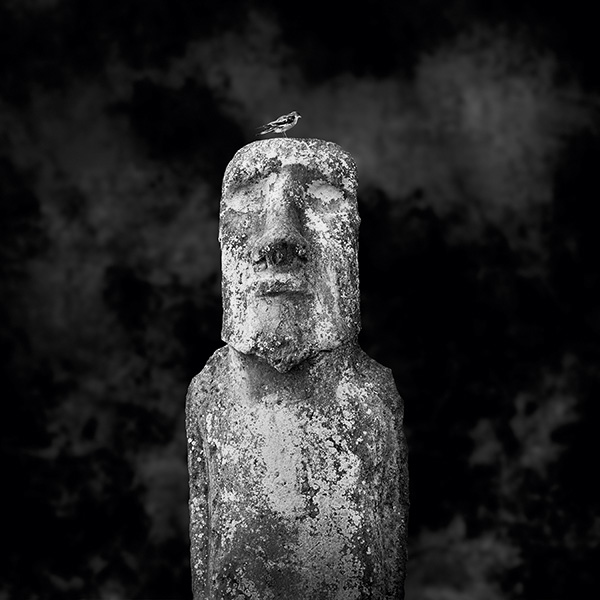
These monolithic figures are called Moai. “The inspiration for this shot came in a dream, as we were flying to Easter Island. I’ve always thought of them as kind of living creatures, and I dreamed that I invited them for a portrait sitting in a photo studio.” Thompson added the backdrop to create the appearance of a studio portrait. The small hawk was part of the scene.
His Favorite Tool
“My favorite item is the Singh-Ray Mor-Slo 15-stop fixed ND filter,” Thompson says. “About 75 percent of the images I shoot these days are long exposures and in the past I had to stack two filters to get 15 stops of ND. This single filter will give me a two-minute exposure in bright sunlight—without the vignetting you normally get with stacked filters.”
To see more of Cole Thompson’s work, visit www.colethompsonphotography.com.




